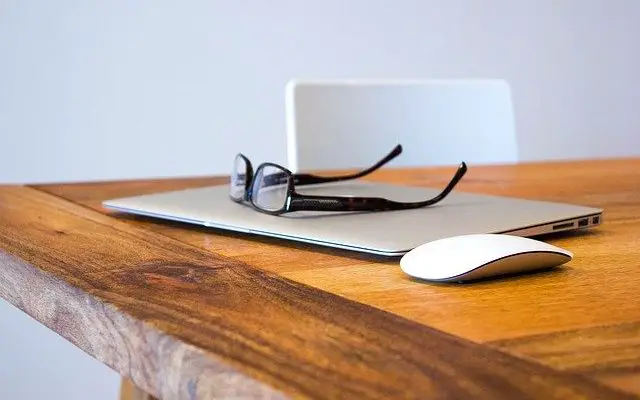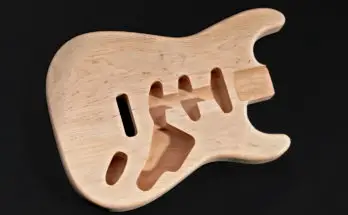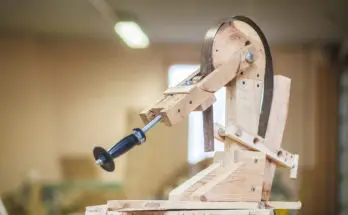If there’s ever been a perfect time for DIY projects, that time is now. While most of the world is still stuck at home, consider these types of wood when making your very own desk.
Hardwood vs Softwood
When aiming for density and sturdiness, consider hardwood for your desk. Materials like aspen, oak, maple, ebony, cherry, alder, walnut, balsa, beech, mahogany, teak, hickory and lignum vitae are all robust and therefore good candidates.
Softwoods such as cedar, juniper, pine, basswood, redwood, yew, larch and spruce can be good choices in their own right, but are generally less dependable as building blocks of furniture due to their softer composition.
Research the hardness of different woods before deciding what’s most suitable for crafting your particular desk. It’s inconvenient to be halfway through construction before realizing your choice of wood is a bad fit.
To Plywood Or Not To Plywood
Materials that should be avoided when making a desk are most preprocessed ones such as particleboards, also known as chipboards or LDFs (low density fiberboards).
MDFs (medium density fiberboards) are more supportive, as are MDOs (medium density overlay boards). But all of them derive from lumber waste products, which is not the best for making a desk meant to last. For that purpose, classic plywood is a substantially better choice.
Plywood is very durable due to its well-made veneers and adhesives, making it the exception among preprocessed materials. But having durability doesn’t mean it’s tough, especially when compared to traditional hardwood.
Go for plywood only if pricing is one of your major concerns and priorities. In most other cases, hardwood is the better choice for your desk.
Durability vs Toughness
Although they may sound like the same thing, durability and toughness describe very different properties of wood.
 Durability refers to a wood’s ability to age well. Highly durable woods will withstand 25+ years of use. These include oak, maple and hickory, and certain other hardwoods.
Durability refers to a wood’s ability to age well. Highly durable woods will withstand 25+ years of use. These include oak, maple and hickory, and certain other hardwoods.
Non-durable woods may be past their prime in less than 5 years. These are typically softwoods, and include woods like pine, balsa as well as materials like LDFs, MDFs, and MDOs. The exception to this rule is plywood, which holds a surprising amount of longevity.
Unlike durability, toughness describes a wood’s ability to maintain its original shape when subjected to outside force. This is measured by pressing a metal ball into the wood until it’s been penetrated by half of its diameter.
Tough wood can withstand a lot of physical pressure, but less tough wood is likely to bend, dent or scratch when subjected to the same force.
A softwood like basswood has a toughness of only 410 lbf, while a medium wood like white oak has 1,360 lbf. But lignum vitae comes in at 4,500 lbf, which is a high level of toughness even for a hardwood. Factor this in when selecting the right material for your desk.
True Colors
When selecting what would to use, you should also be taking into account its color, and colors vary greatly among different species of tree. This matters because it’s more convenient to decide a desk’s color based on the natural shade of the wood as opposed to subjecting it to artificial dye.
It is only when your wood’s natural color conflicts heavily with the desk you have in mind that you should consider dyeing it. But that applies to hardwood. Most softwoods don’t accept dyes very well, which may result in your desk aging poorly, at least as far as looks go.
If you decide to stay with the natural color of your wood, types like maple, aspen and oak are bright, blonde and inviting choices. Walnut and ebony are on the darker side of the spectrum with a tone that’s less playful and more serious.
In between these opposites, you’ll find the charming uniqueness of cherry (a reddish color), the warm delight of mahogany (red to brown), and the pleasing look of rosewood (brown to purple). Explore the fauna of colorful woods before settling on a particular one.
It’s What’s On The Inside That Matters… Or Is It?
Using several materials for a desk is common. Why? Because by cutting out sheets of high-end wood, you can use these as your veneers.
Since the core of your desk isn’t directly exposed to sun light (which otherwise causes color fading in many woods), using a more basic material underneath your veneers isn’t just practical. It can also make a lot of economic sense.
When you’re spending only a portion of your funds on your most expensive wood, you’re not shelling out nearly as much cash on your combined materials. Your desk now has the outward appearance of a high level desk, while the cost of construction matches that of a low-to-medium level one.
Saving A Buck
A major perk of crafting your own piece of furniture is the relatively low cost. Lower than getting it custom made for you, that is.

Making your own desk will run you substantially less than the thousands of dollars that most professional makers charge for a desk, not to mention the lengthy time you may need to wait to see it finished. But even if you’re going it alone, cost will still vary.
Purchasing hardwood will typically make your project more costly than if you use softwood. If it’s a rare type of hardwood, such as ebony or mahogany, expect even higher prices when making your purchase, as hard to come by materials fetch a substantial price tag.
Softwoods such as pine and spruce are very affordable. Granted, they won’t keep your desk from decaying with time or protect it completely from bending. But that doesn’t mean they’re not a good value considering their low price.
That said, investing in a cheaper type of wood isn’t the only way of saving money. Another way of saving a buck is one that also, inadvertently, does a favor for Mother Nature.
Something Old, Something New
Reclaimed wood is wood that’s been used prior and is repurposed for something new. Because it is substantially cheaper to acquire than new wood and more environmentally friendly, this type of wood has seen a rise in popularity in recent years.
Using reclaimed wood doesn’t contribute nearly as much to the harmful effects of logging as new wood does, which means less deforestation and less carbon dioxide emitted into the atmosphere. But what if you’re planning to purchase new wood?
If you’re using a type of wood that comes from a threatened species of tree, being environmentally conscious becomes even more important. Species that are currently threatened with extinction include ebony, mahogany, redwood, walnut and several others. So research various species of tree on their current state before deciding which one to use.
The easiest way to go green and a not have to deal with a head ache is simply to purchase wood that derives from sustainably managed forests. That way, you can delegate (at least some of) the responsibility of protecting the environment to those who know it best while you dedicate your time to working on the desk of your dreams.
Decision Time
Once you’ve taken everything from wood type, to durability and toughness, to color, to pricing, to environmental impact into account, it’s time to make your decision.
Should your desk be durable and tough rather than pleasing to look at? Should it aim at good value rather than high quality? Or does none of the above matter, as long as it’s the most eco-friendly option?
Since you’re the one crafting your desk, only you can answer these questions. No matter what you decide, however, one thing is for certain: Just like you, it will be completely unique.




